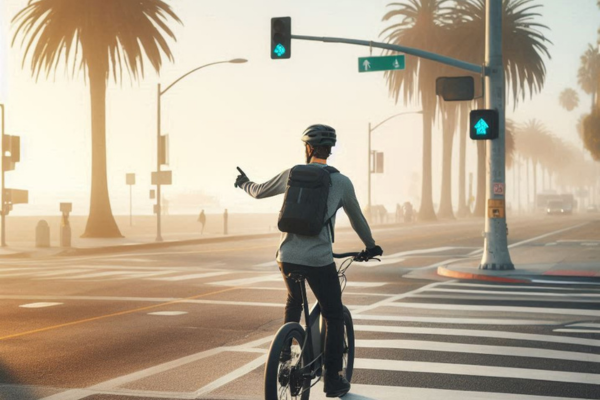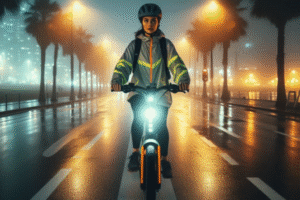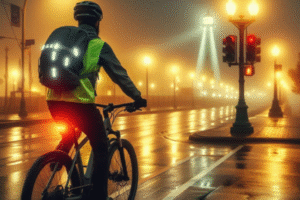🚦 Navigating Intersections Safely in Coastal Cities During Your Commute
Commuting by e-bike through coastal cities—like Santa Monica, Cartagena, San Sebastián, or Miami—offers stunning scenery, fresh ocean air, and vibrant coastal energy. But amidst that beauty lies one of the most frequent danger zones for riders: intersections. These points of convergence become even more complex in seaside cities, where visibility may be reduced by morning mist, streets may be slick from salt spray, and tourist traffic adds unpredictability.
Whether you’re crossing palm-lined boulevards near the marina or navigating intersections close to beachfront promenades, understanding how to approach these environments safely is critical. This guide will walk you through the risks unique to coastal intersections and provide practical techniques to ensure your visibility, confidence, and control as you ride to work.
🌊 What Makes Intersections in Coastal Cities Riskier?
Riding through intersections near the sea involves more than just managing traffic—it means adapting to environmental factors specific to coastal life:
- Humidity and fog: Morning sea mist or high humidity levels can obscure vision for both cyclists and drivers.
- Slick surfaces: Salt residue, sand, or algae from nearby tides may reduce traction at crosswalks or traffic lines.
- Tourist distractions: Intersections near beaches and piers are often crowded with visitors unfamiliar with local traffic rules.
- Mixed-use zones: Coastal cities often blend pedestrian walkways, bike paths, and motor traffic in tight areas.
These factors combine to increase the unpredictability of intersections, especially during peak commuter hours or holiday weekends. As an e-bike commuter, your best protection is preparation.
🚴♀️ Know the Flow—Be Ready to Adapt
In coastal environments, intersections are not just structured points of crossing—they’re living systems influenced by waves of tourism, weather, and city design. One morning, your usual route might be clear; the next, it could be blocked by a market day or a film crew shooting along the boardwalk.
- Check conditions before you ride: Use apps to track fog, traffic, and coastal weather alerts.
- Adjust expectations daily: Know that intersections near the water may behave differently than inland city grids.
- Slow down early: Begin scanning for movement well before reaching each intersection, especially near tourist zones.
💡 Tip: When riding near the coast, intersections aren’t just crossings—they’re micro-climates. Fog, wind, sand, and people shift daily. Anticipate, adjust, and ride through them with clarity.
In the next block, we’ll dive into specific positioning strategies and lane management when approaching intersections near piers, beachfronts, and coastal downtowns—because where you place yourself on the road matters more when ocean winds and distractions are part of your commute.
🛣️ Lane Positioning in Coastal Intersections: Visibility Starts with Where You Ride
In coastal cities, intersections are often nestled between beachside cafés, open-air markets, and tourist promenades. This urban-seaside mix means lane markings may be faded by sun and salt, surfaces may be slick from sea mist, and vehicle behavior may be erratic near attractions. That’s why how and where you ride makes a critical difference at every intersection.
Proper lane positioning not only helps you stay visible through fog and distraction—it helps you ride in a way that drivers recognize and respect. The ocean breeze may feel calm, but the intersection ahead might be a tangle of beach buses, scooters, and pedestrians carrying surfboards. You need to be seen—and understood.
📍 Own Your Space with Confidence
Riding too close to the curb near a marina or beachfront road is risky. Cars turning right may not expect you, and a sudden gust of wind can shift your line at the worst moment. Instead, take a lane position that reinforces your presence.
- Ride in the center of the bike lane, or if there is no lane, take the right third of the traffic lane where you’re visible but not crowding vehicles.
- In humid coastal areas, avoid hugging edges where tile, algae, or sand may collect and reduce traction.
- At intersections with heavy foot traffic (common near beach plazas), position yourself slightly ahead of vehicles at red lights to claim visibility.
A confident, central position helps you avoid hazards like sudden car door openings from parked vehicles or aggressive passing by impatient drivers trying to beat the morning tide.
🧭 Adapt Your Approach to the Coastal Layout
Beach towns and port cities often have unconventional layouts. You may find yourself at a five-way intersection or a diagonal crossing toward a pier. In these scenarios, planning your approach matters.
- Choose your lane early: If you’ll be turning or crossing near tourist shuttle stops, merge well before the intersection.
- Use painted bike boxes or waiting zones when available—especially at boardwalk intersections where right-turning vehicles may not notice you.
- Account for visibility drops: If morning mist or sea haze is present, reduce your speed before approaching a crossing and increase your signaling distance.
Remember that other road users may be unfamiliar with the area. Ride predictably and position yourself where hesitation won’t put you in danger.
💡 Tip: On coastal roads, faded lines, salty surfaces, and tourist traffic require more than awareness—they demand presence. Ride where drivers look, not where it’s most convenient.
Up next: we’ll tackle how to handle **complex coastal intersections**—from roundabouts near ports to uncontrolled junctions by the beach—and how to navigate them with calm, clarity, and control.
🌀 Complex Intersections by the Sea: Confidence at Coastal Crossings
Not all intersections in coastal cities are neatly organized. In many beach towns and historic port districts, intersections can be irregular, busy, and unpredictably designed—especially in older urban layouts where roads were built before e-bikes were ever imagined. Roundabouts near ports, diagonal tourist zones, and faded crossings without signage are common. These situations require not just alertness, but adaptability and confidence.
Let’s explore how to handle these complex crossings—whether it’s a four-way without stop signs near the oceanfront, a busy roundabout next to a marina, or a chaotic intersection where tour vans, scooters, and bike taxis all converge.
🔄 Roundabouts in Coastal Port Zones
Roundabouts near coastal docks or ferry terminals often have unique traffic patterns due to loading zones, buses, and delivery vans. Many of these areas are high-friction zones for cyclists because of limited space and unpredictable movement.
- Ride assertively in the center of the lane when entering the roundabout—don’t stay along the edge where large vehicles might clip you.
- Signal your exit early and maintain a steady speed to avoid hesitation that confuses drivers.
- Watch for crosswinds—sudden gusts near open waterfronts can shift your balance while turning.
If the roundabout feels overwhelming during peak hours, especially near cruise drop-offs, dismounting and walking your e-bike through the pedestrian crosswalk may be the safer option.
🛣️ Multi-Directional Coastal Crossings
In some coastal cities, intersections near markets or tourist hubs aren’t traditional four-way stops. You may encounter five-way or diagonal crossings where traffic comes from unexpected angles.
- Pause and observe the flow: Before entering, assess all directions—don’t assume anyone else knows the rules.
- Signal clearly and early—especially when your turn angle isn’t intuitive to nearby vehicles.
- Take your time crossing if the layout is unclear. Confidence and clarity are better than speed in unfamiliar zones.
When in doubt, dismounting in high-traffic pedestrian areas gives you full control and increases your visibility among distracted tourists.
🚧 Uncontrolled Intersections in Seaside Neighborhoods
In older or more residential coastal areas, intersections without stop signs or traffic lights are common. Here, trust and anticipation are your best tools.
- Slow down before each crossing—especially when palm trees or parked cars block side views.
- Look left-right-left twice, since drivers often roll through without stopping near the beach.
- Be patient with unfamiliar drivers—many tourists in rental cars may hesitate or ignore right-of-way norms.
💡 Tip: In coastal cities, intersections evolve with the season. Ride slowly, read the behavior of others, and don’t expect consistency—expect awareness.
Up next in Block 4: how to use body language, hand signals, and eye contact in coastal intersections, where distractions abound and fog, wind, or festive noise can make communication more visual than verbal. 🚴♀️🌬️👁️
👁️ Coastal Communication: Body Language and Visual Cues at Seaside Intersections
Intersections in coastal cities are often vibrant but chaotic spaces. Between the crashing waves in the background, chatter from tourists, and delivery trucks humming past seafood markets, it’s easy for your voice or bell to get drowned out. That’s why effective communication in these environments is primarily visual. The way you use your body, your signals, and even your gaze can influence how safely you’re seen and respected.
Whether you’re riding past a pier in La Rochelle, cutting through a foggy port district in San Francisco, or approaching a busy traffic circle in Cartagena, mastering non-verbal communication becomes your most powerful safety tool.
🖐️ Signal Like the Ocean Is Watching
Hand signals are essential in any setting, but in foggy or humid coastal conditions, they must be bold and unmistakable. Misty air can soften contrast, and backlight from the rising sun over the sea may obscure your movements.
- Signal at least 3–5 seconds before your turn, especially if ocean glare affects visibility for oncoming traffic.
- Extend your entire arm—no half-gestures or quick flicks—hold the signal long enough to ensure it’s been seen.
- Repeat your signal if you’re unsure whether drivers or pedestrians caught it—especially in tourist-heavy areas where attention is scattered.
📏 Ride with Posture That Commands Space
Riding along a beachside avenue or coastal highway, your posture tells others how to treat you. Unsteady movements or riding too close to the curb suggests indecision—dangerous near docks where large vehicles may pass tightly.
- Ride upright and centered—even in windy conditions, your control inspires confidence in those around you.
- Hold a consistent path through intersections, even if the road is uneven or sandy.
- Reduce unnecessary head tilting or wobbling, which can confuse motorists or signal hesitation.
In coastal areas where streets are often narrower and lines are faded from sun and salt, your steadiness becomes your visibility.
👀 Make Eye Contact with Drivers and Pedestrians
Tourists, ride-share drivers, and delivery vans don’t always follow local rules—especially near the coast. Making eye contact becomes your silent agreement that both parties are aware of each other.
- At four-way stops near beach towns, always seek eye contact before proceeding—it reduces misinterpretations.
- At zebra crossings near marinas or cruise terminals, use a small hand gesture or nod to acknowledge pedestrians or drivers who yield.
- Never assume someone saw you just because you’re in their path—fog, glare, or distraction can delay their reaction.
💡 Tip: In cities kissed by the sea, traffic doesn’t just flow—it swirls. Use your signals and posture to cut through the noise and be unmistakably present.
And now, let’s wrap it up with Block 5: we’ll explore key FAQs from coastal commuters, leave you with an inspiring reminder, and invite you to share your own crossing wisdom from the shorelines you call home. 🌅🚴♀️💬
💬 FAQs for Coastal Commuters: Conquering Intersections by the Sea
1. How should I handle an intersection near a beach festival or outdoor event?
Slow down well in advance and scan for temporary barriers, police redirection, or sudden pedestrian crossings. Visibility may be compromised due to tents, food trucks, or distracted visitors. Take a wide arc around congested areas, and consider walking your bike if movement becomes unpredictable.
2. Is fog near the coastline really that dangerous at intersections?
Yes. Sea mist or early morning fog can drastically reduce visibility, especially at intersections where drivers may not expect fast-moving cyclists. Always ride with front and rear lights, wear reflective gear, and reduce your speed when fog is present.
3. Should I trust painted bike lanes near oceanfront intersections?
Treat them with caution. Salt, sand, and humidity often wear out paint quickly. Bike lane markings may be faded or slippery, especially near piers or docks. Prioritize your position over painted guidance—ride where you’re safest, not where the line says you should be.
4. What if an intersection has no signage near a boardwalk zone?
In beach towns, many intersections are uncontrolled. Slow down, make eye contact with all nearby users, and yield when in doubt. Tourists and beachgoers may not know the area, so riding defensively protects everyone.
5. How can I communicate with drivers who don’t speak the local language?
Use universal signals: big hand gestures, confident posture, and facial expressions. A nod or open hand wave often communicates more than words. In cities with high tourism, visual clarity beats verbal instructions every time.
💖 Final Thoughts: Intersections Are More Than Asphalt—They’re Encounters
Every time you approach a crossing in your coastal city, you’re not just riding through lines and signals—you’re moving through shared space. A zone of interaction. A brief moment where your presence matters.
Whether you’re skimming the sea breeze down a boardwalk in Valencia or navigating a misty pier-side avenue in Vancouver, your awareness, respect, and clarity elevate the entire riding experience—for you and for others. You don’t just survive the crossing. You transform it.
💡 Tip: Every intersection is a moment to connect—with people, with rhythm, with the pulse of your city. Ride like you’re part of it—because you are.
🌴 Share Your Coastal Commuter Wisdom
Do you ride through intersections with the sunrise over the ocean? Have you found a technique that keeps you visible when the breeze picks up and the boardwalk bustles? Your story could help someone ride safer tomorrow.
Let’s hear from you in the comments:
🌤️ What’s your best tip for navigating coastal crossings?
🚴♀️ What intersection has taught you the most as a rider?
🌎 What do you think drivers, tourists, and new cyclists should know about sharing space near the sea?
Because at the end of the day, intersections are not interruptions—they’re invitations. To ride smarter, to be seen, and to lead with purpose in the most beautiful cities on Earth. 💛🌊🚦



